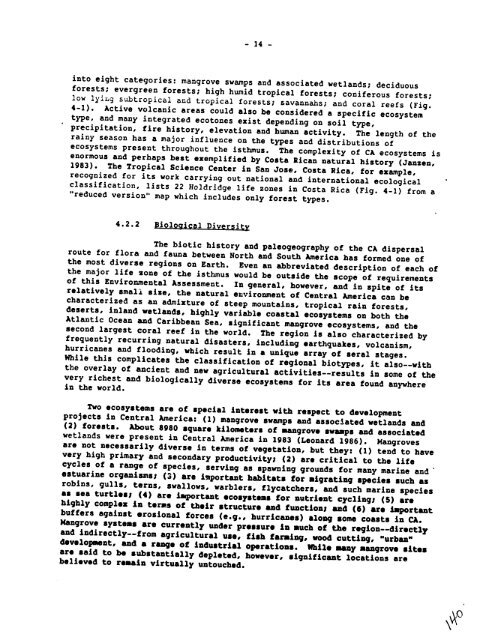MUNZSSInlD - usaid
MUNZSSInlD - usaid
MUNZSSInlD - usaid
Create successful ePaper yourself
Turn your PDF publications into a flip-book with our unique Google optimized e-Paper software.
- 14 <br />
into eight categories: mangrove swamps and associated wetlands; deciduous<br />
forests; evergreen forests; high humid tropical forests; coniferous forests;<br />
low lying subtropical and tropical forests; savannahs; and coral reefs (Fig.<br />
4-1). Active volcanic areas could also be considered a specific ecosystem<br />
type, and many integrated ecotones exist depending on soil type,<br />
precipitation, fire history, elevation and human activity. The length of the<br />
rainy season has a major influence on the types and distributions of<br />
ecosystems present throughout the isthmus. The complexity of CA ecosystems is<br />
enormous and perhaps best exemplified by Costa Rican natural history (Janzen,<br />
1983). The Tropical Science Center in San Jose, Costa Rica, for example,<br />
recognized for its work carrying out national and international ecological<br />
classification, lists 22 Roldridge life zones in Costa Rica (Fig. 4-1) from a<br />
"reduced version" map which includes only forest types.<br />
4.2.2 Biological Diversity<br />
The biotic history and paleogeography of the CA dispersal<br />
route for flora and fauna between North and South America has formed one of<br />
the most diverse regions on Earth. Even an abbreviated description of each of<br />
the major life zone of the isthmus would be outside the scope of requirements<br />
of this Environmental Assessment. In general, however, and in spite of its<br />
relatively small size, the natural environment of Central America can be<br />
characterized as an admixture of steep mountains, tropical rain forests,<br />
deserts, inland wetlands, highly variable coastal ecosystems on both the<br />
Atlantic Ocean and Caribbean Sea, significant mangrove ecosystems, and the<br />
second largest coral reef in the world. The region is also characterized by<br />
frequently recurring natural disasters, including earthquakes, volcanism,<br />
hurricanes and flooding, which result in a unique array of seral stages.<br />
While this complicates the classification of regional biotypes, it also--with<br />
the overlay of ancient and new agricultural activities--results in some of the<br />
very richest and biologically diverse ecosystems for its area found anywhere<br />
in the world.<br />
Two ecosystems are of special Interest<br />
projects<br />
with respect<br />
in Central<br />
to development<br />
America: (1) mangrove swamps and associated<br />
(2) forests.<br />
wetlands<br />
About<br />
and<br />
8980 square kilometers of mangrove<br />
wetlands<br />
swamps<br />
were present<br />
and associated<br />
in Central America in 1983 (Leonard<br />
are<br />
1986).<br />
not necessarily<br />
Mangroves<br />
diverse in terms of vegetation, but they:<br />
very<br />
(1)<br />
high<br />
tend<br />
primary<br />
to have<br />
and secondary productivity; (2) are<br />
cycles<br />
critical<br />
of a range<br />
to the<br />
of<br />
life<br />
species, serving as spawning grounds<br />
estuarine<br />
for many<br />
organisms;<br />
marine and<br />
(3) are important habitats for<br />
robins,<br />
migrating<br />
gulls,<br />
species<br />
terns,<br />
such<br />
swallows,<br />
as<br />
warblers, flycatchers, and<br />
as sea<br />
such<br />
turtles:<br />
marine species<br />
(4) are important ecosystems for nutrient<br />
highly complex<br />
cycling;<br />
in<br />
(5)<br />
terms<br />
are<br />
of their structure and function;<br />
buffers<br />
and<br />
against<br />
(6) are<br />
erosional<br />
important<br />
forces (e.g., hurricanes) along<br />
Mangrove<br />
some coasts<br />
systems<br />
in<br />
are<br />
CA.<br />
currently under pressure in much of the<br />
and<br />
region--directly<br />
indirectly--from agricultural use, fish farming,<br />
development,<br />
wood cutting,<br />
and<br />
"urban"<br />
a range of Industrial operations. While<br />
are<br />
many<br />
said<br />
mangrove<br />
to be substantially<br />
sites<br />
depleted, however, significant locations are<br />
believed to remain virtually untouched.

















